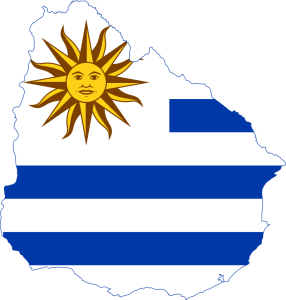Everything You Need To Know For Uruguay
Geographical Position And Climate Of Uruguay
Uruguay is situated in the southeastern region of South America, bordered by Brazil to the north, Argentina to the west, the Atlantic Ocean to the southeast, and the Rio de la Plata to the south. Uruguay’s terrain is predominantly rolling plains and low hill ranges (cuchillas) with a fertile coastal lowland. The country lacks extreme topographical features, with its highest point being Cerro Catedral at an elevation of 514 meters (1,685 feet).
The landscape includes grassy meadows and farmland interspersed with rivers and coastal lagoons. The longest river in the country is the Río Negro, which runs through central Uruguay from east to west, dividing the country into northern and southern regions. The coastline along the Atlantic Ocean features beautiful beaches and dunes, contributing to Uruguay’s tourism industry. The climate in Uruguay is temperate, with warm summers and cool winters.
Brief History Of Uruguay
Before European colonization, Uruguay was inhabited by the Charrúa people, along with other smaller indigenous groups such as the Guarani. The Charrúas were semi-nomadic people who lived off hunting and gathering.
The Spanish arrived in the territory of present-day Uruguay in 1516. However, due to the absence of precious metals and the fierce resistance of the Charrúa, the area was not a priority for settlement. It wasn’t until the second half of the 17th century that significant numbers of Spaniards began to settle, founding the city of Montevideo in 1726.
During the early 19th century, Uruguay became a battleground between Spain, Portugal, and later Brazil, as well as the emerging independentist forces. The fight for independence was intertwined with Argentina’s struggles and the broader Latin American wars of independence. José Gervasio Artigas emerged as a national hero leading the resistance against foreign domination and striving for a federal organization of the Provinces of the Rio de la Plata.
After a series of conflicts, including the Brazilian occupation and the subsequent Cisplatine War, Uruguay declared its independence in 1825, which was finally recognized in 1828 with the Treaty of Montevideo mediated by the United Kingdom.
In the latter half of the 20th century, like many countries in South America, Uruguay experienced a period of military dictatorship from 1973 to 1985. Democracy was restored with the election of Julio María Sanguinetti. Uruguay is now considered one of the most socially advanced countries in Latin America. With high rankings in democracy, peace, low perception of corruption, and e-government.
Religion
The most practiced religion in Uruguay is Christianity. Almost half of the population define themselves as atheists.
Language
The country’s official language is Spanish. English is also spoken by many people in Uruguay.

Welcome to the delightful country of Uruguay! Often overlooked gem in South America that offers a rich tapestry of cultural experiences, beautiful landscapes, and a laid-back atmosphere. Whether you’re basking on the sun-drenched beaches of Punta del Este, exploring the cobblestone streets of Colonia del Sacramento, or indulging in the vibrant nightlife of Montevideo, Uruguay promises an unforgettable journey.
Places You Must Visit In Uruguay
- Montevideo
- Punta del Este
- Colonia del Sacramento
- Piriápolis
- Salto
- Punta del Diablo
- Cabo Polonio National Park
- Santa Teresa National Park
Before You Visit Uruguay
Travel to Uruguay
Travelers can get to Uruguay primarily by air, with the main international airport being Carrasco International Airport, located just outside Montevideo, the capital city. There are direct flights from several cities in South America, North America, and Europe.
Alternatively, visitors can enter Uruguay by land from neighboring Argentina and Brazil. The most common entry points from Argentina are via the international bridges that connect the two countries or by ferry across the Río de la Plata to Montevideo or Colonia del Sacramento.
Once in Uruguay, domestic travel is facilitated by an extensive bus network that connects major cities and tourist destinations. Car rentals are also available for those who prefer more flexibility in their travel plans.
Visas for Uruguay
Visa requirements for Uruguay are relatively relaxed. Many travelers, including those from the United States, Canada, most European countries, Australia, and New Zealand, do not require a visa to enter Uruguay for tourist or business purposes for stays of up to 90 days.
Travelers from countries that do require a visa must apply at a Uruguayan consulate or embassy prior to their arrival. The types of visas include tourist, business, and work visas, among others.
It is important for all travelers to check the latest visa requirements with the nearest Uruguayan diplomatic mission or their official government website before planning their trip, as visa policies can change. Visitors should also ensure their passport is valid for at least six months beyond the date of entry into Uruguay.
Best time to visit Uruguay
The best time to visit the country is during the Southern Hemisphere’s spring and summer months, from October to March. During this period, the weather is warm and pleasant, making it ideal for enjoying the country’s beautiful beaches, outdoor activities, and cultural events.
December to February is peak tourist season. Especially in coastal areas like Punta del Este, where visitors flock to enjoy the vibrant nightlife and sunny days. For those interested in attending local festivals, the famous Carnival celebrations take place in late January or early February.
If you prefer a quieter visit with fewer crowds, the shoulder seasons of spring (October to November) and fall (April to May) offer mild temperatures and lower accommodation rates. Keep in mind that winter (June to September) can be quite cool. Particularly in the interior, although it’s still a good time to explore the cities and enjoy the local cuisine without the crowds.
Important Information
Capital – Montevideo
Territory – 176,215 km2
Currency – Uruguayan peso
Time Zone – UTC-3 (UYT)
Population – 3,444,263
Demonym – Uruguayan
